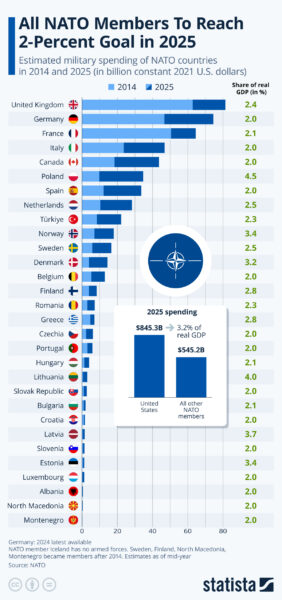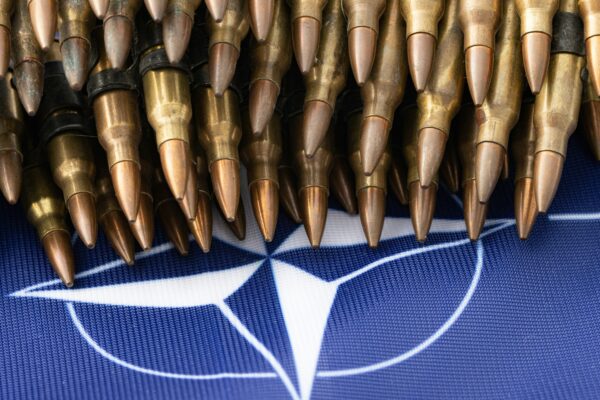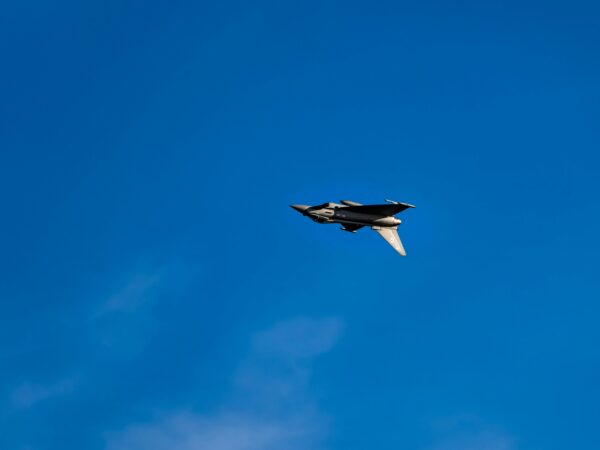By Michael Ofori-Mensah, Head of Research, and Léa Clamadieu, Research Project Officer
In 2024, global military expenditure rose for the tenth consecutive year, reaching an unprecedented $2.7 trillion. All five geographical regions of the world recorded an increase in military expenditure. Significantly, according to SIPRI, NATO members alone accounted for $1.5 trillion—around 55 per cent of the total global spending. This figure is set to grow further following the Alliance’s June 2025 commitment to increase national defence budgets to 5 per cent of GDP.
While this surge underscores the renewed emphasis on collective security, it also brings significant corruption and governance risks. Defence budgets are often shrouded in secrecy, with parts of spending channelled through off-budget mechanisms that escape parliamentary scrutiny and public oversight. As highlighted by UN Secretary General Antonio Guterres in his report The Security We Need, such opacity erodes political control over public finances; heightens the risks of inefficiency, corruption and mismanagement; and diverts resources from essential public services and sustainable development. Defence procurement processes -frequently among the least transparent areas of government – are also vulnerable to corruption, waste, and political capture.

This is not just a threat on paper – it is very much real: A recent investigation by La Lettre and partner news outlets brought to light how criminal networks exploit corruption loopholes to win contracts awarded by the NATO Support and Procurement Agency (NSPA), and how kickback schemes built a system of corruption between the NSPA and former staff. Pressure on audit institutions and lack of support for whistleblowers was found to further limit oversight and meaningful anti-corruption measures.
This moment presents a risk, but also an opportunity. The NATO Building Integrity programme, which works to promote good governance and integrity reform, has made a positive contribution. However, with unprecedented resources being mobilised, NATO member countries can strengthen transparency, accountability, and governance frameworks to ensure that all military expenditures serve their intended purpose.
To support this, we have has identified examples of best practice from across NATO countries, recognising that systems and approaches differ – but that valuable lessons can be shared. Drawing on insights from our Government Defence Integrity Index (GDI), we highlight a selection of good practices across three key risk areas:
- Policymaking: Defence sector oversight and civil society inclusion
- Financial: Transparency in actual defence spending
- Procurement: Integrity and openness in defence purchases
At the core of the examples is embedding integrity in the defence sector, defined here as “institutional resilience to corruption”, these cases demonstrate that strong oversight and openness are not obstacles to security—they are essential foundations for it.

Photo by Marek Studzinski on Unsplash
Policymaking: Oversight and CSO inclusion
Identifiable and effective parliamentary defence and security committee exercising short- and long-term oversight
Members of parliamentary Defence Committees should comprise individuals with defence sector expertise experience in the field of security for oversight to be effective. In terms of short-term oversight of the Defence Committee, the regularity of committee’s meetings, the depth of the debate as well as public access are key to promote efficient parliamentary oversight. In Latvia, the Defence Committee meets at least twice a week and issues budget amendments and recommendations which are developed in collaboration with ministries. Issues debated are legislative, including preparing draft legal acts and policy planning documents, and non-legislative, such as informative or investigative meetings. The same frequency of meetings is noted in Belgium, where the debates from representatives are also thoroughly documented and publicly available with dates and integral text of the debate documented in a question-and-answer format.
The Committee should also be able to conduct long-term investigations such as current defence activities or military operations like in the Netherlands and be able to invite ministries and other institutions to report on specific issues like in Latvia. Once recommendations are made by the Parliamentary Committee, it is important that the Ministry of Defence (MoD) acknowledge and incorporate them. For instance, in the Netherlands there is first an internal debate on the topic at hand and external with the Ministry. If a specific Member of Parliament is not satisfied with the result of discussions, they can put the recommendation into a motion for the plenary to vote on. If the majority votes in favour, the ministry is obliged to implement the recommendation.
Policy, or evidence, of openness towards civil society organisations (CSOs) when dealing with issues of corruption
It is essential that CSOs operate free from government interference and intimidation and more importantly that defence and security institutions engage and work regularly with them on corruption issues. This engagement can take different forms. In Norway, the MoD created the Centre for Integrity in the Defence Sector (CIDS) in 2012 which seeks to promote and enhance professional integrity and good governance in the defence and security spheres. Its work includes collaborating with a range of CSOs. Moreover, in the Netherlands, military personnel often work together with civilians and civil society organisations, with expertise in public administration, government, law enforcement and justice, in mission areas. CSOs can offer practical and tangible inputs into the defence policymaking and accountability processes.
Financial: Transparency of actual defence spending
Good practice requires that all spending related to personnel, procurement, R&D and other categories should be disclosed with very few exceptions. In Latvia and the United Kingdom, actual defence spending is published annually in a comprehensive format and includes detailed explanations for all audiences (expert and non-experts). Good practice also requires MoDs to explain the variances between the published budget and actual spend. The UK, for example, publishes a 200-page report on annual accounts and performance with detailed expenditures and explanations. Additionally, actual spending should be published within six months after the end of the financial year and scrutinised by an independent oversight institution, as in the case of the UK.

Procurement: Integrity and openness in defence purchases
Oversight of defence procurement
Oversight of defence procurement should be independent and effective. In Norway, in addition to internal auditing of defence procurements by the Internal Auditor Unit and the Contract Audit section, external auditing is conducted by the Office of the Auditor General (OAG). The OAG may also initiate in-depth investigations of the defence sector. In Finland, the Parliamentary Committees also discuss procurement. These oversight bodies work free from undue influence from the executive or military. In Finland, Latvia and Norway, the oversight bodies are active in summoning witnesses and documents, demanding explanations, and issuing recommendations and conclusions that must be followed. Moreover, they also publish reports on their findings, which are accessible to the public.

Photo by SaiKrishna Saketh Yellapragada on Unsplash
Transparency of actual purchases
Good practice standards in defence procurement requires that actual defence purchases are made public with almost no exceptions. The amount spent, reason for expenditure and companies involved should be also disclosed in an Excel format for readability. In Finland, all defence purchases are published on the ‘Hilma’ system – a digital notification channel where public sector buyers announce their upcoming procurement plans, ongoing tendering procedures and the results of tenders that have already ended; it is owned by the Ministry of Employment and the Economy. In Norway, all contracts above a set threshold must be published in DOFFIN (the Norwegian National Database for Public Procurement) and TED (Tenders Electronic Daily). In the UK, data on all spending above £25,000 is available in an accessible format, viewable online and published monthly.

Open competition
All procurement should as far as possible be based on open competition and the percentage of singled source contract be transparent. Additionally, in terms of oversight, all single-source procurements need to be justified and scrutinised by an oversight body like Supreme Audit Institution, as in the case of Latvia and Norway.
As military budgets surge across NATO member countries and beyond, the need for arming with integrity – strengthening institutional resilience to corruption risk – and embedding good practice standards in the defence sector has never been greater. Rising military spending can strengthen security but only if matched by equally strong systems of accountability, transparency, and public oversight. The examples highlighted show that practical measures—such as empowered parliamentary committees, open engagement with civil society, transparent reporting, and independent procurement audits—can make a tangible difference.

